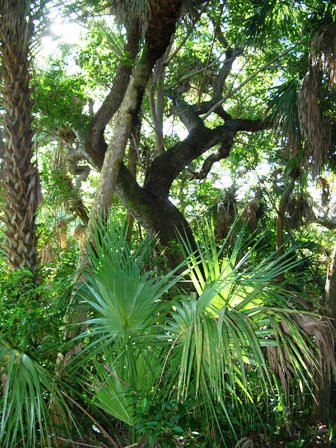Discover Florida Nature
It's time to explore the natural Florida


|
|
|
|
|
 Temperate
Hardwood Forests are part of the Upland Ecosystem. Prior to the advent
of air conditioning, Florida was an unbearable place for people to live.
The things that sustained Florida before tourism were turpentine
harvesting, logging and other industries that depended on these upland
ecosystems. Hardwood hammocks are localized, thick stands of hardwood
trees that can grow on natural rises of only a few inches of land. In
South Florida, hammocks occur in marshes, pinelands, and mangrove
swamps. Temperate
Hardwood Forests are part of the Upland Ecosystem. Prior to the advent
of air conditioning, Florida was an unbearable place for people to live.
The things that sustained Florida before tourism were turpentine
harvesting, logging and other industries that depended on these upland
ecosystems. Hardwood hammocks are localized, thick stands of hardwood
trees that can grow on natural rises of only a few inches of land. In
South Florida, hammocks occur in marshes, pinelands, and mangrove
swamps.Hammocks are diverse hardwood forests. North Florida hammocks have the greatest number of tree and shrub species per acre of all temperate forests in the continental United States. They also provide homes for other plants and animals. Some of these species occur nowhere else in the world. People in Florida have long enjoyed hammocks as cool, shady, places for walks, picnics, and homesteads. Organic matter, soil moisture, and slope determine the mix of plants. The hydric hammock is wet; the xeric hammock is dry; the mesic hammock is in-between. SUBSTRATE: Soils generally contain more organic matter and moisture than adjacent, well-drained sandy soils. TOPOGRAPHY: On slopes between upland pinelands and lake margins, or floodplain forests and marshes; also in some uplands protected from fire. VEGETATION: In typically narrow bands; varies from warm temperate, mixed deciduous-evergreen flora (e.g., oaks, hickories, beech, magnolia) in north to subtropical evergreen flora in south; many species of trees, but few species of herbs, except for diverse ferns in peninsular hammocks; hammocks on the Apalachicola Bluffs contain Torreya taxifolia, a tree on the verge of extinction, as well as other endemic plant species. FAUNA: Diversity of vertebrates, including bobcat, gray fox, white-tailed deer, southern flying squirrel, Mississippi kite, barred owl, pileated woodpecker, eastern diamondback rattlesnake. PROCESSES / DYNAMICS / ABIOTIC FACTORS: Continually being modified by changing and variable environment; combinations of species in some hardwood forests were not present before European settlement. NEGATIVE IMPACTS: Amount of land in hammocks has changed little over past 200 years, but composition of plant species has been affected by human disturbance; increasingly threatened by residential / commercial development, e.g., around Gainesville and Tallahassee. The dominate species in this habitat classification varies depending on its location in the state. Hammocks located in the panhandle are dominated by several species of oaks, hickories, and magnolias. There is a diverse understory and a number of plants that are found only in this part of the state. In the north central part of Florida, the hammocks begin to transition from ones dominated by temperate species to one with a tropical influence. Oaks species are dominate with cabbage palms becoming more abundant the further south you look. The oaks of this region tend to be evergreen species. The coastal hammocks of the southern part of the state contain the highest percentage of tropical hardwoods. Evergreen oaks grow with gumbo-limbo, mastic, strangler figs, and a variety of tropical understory plants. |
|
|
Advertise | Privacy Statement | Dog Encyclopedia | Video |Contact | Alaska Nature |
|